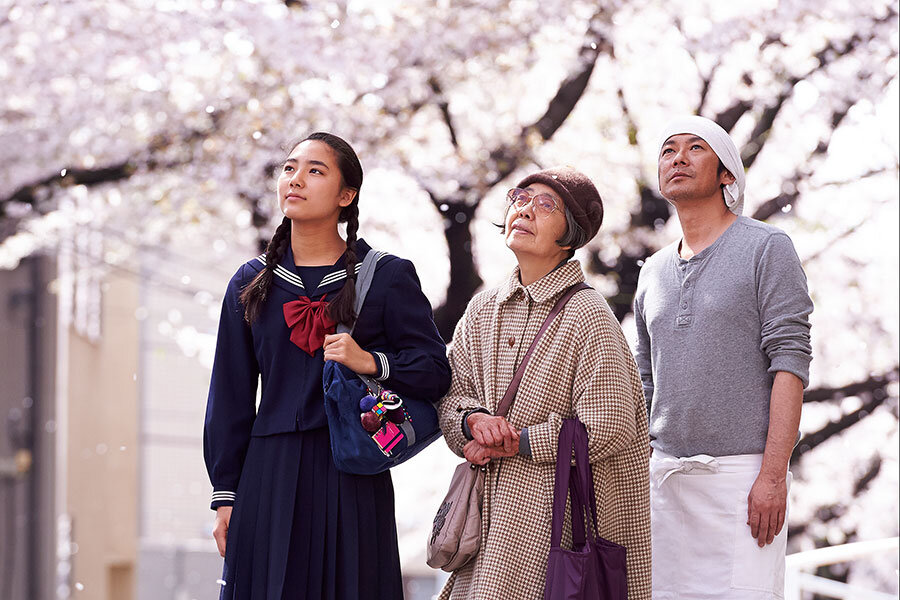'Sweet Bean' is a delicate little fable held together by actress Kirin Kiki
Loading...
“An” is the sweet azuki bean paste that serves as the filler in the pancake-like Japanese dorayaki. “Sweet Bean” is probably the only movie that provides what amounts to a tutorial in how to make the perfect dorayaki. In that sense, and in that sense only, it recalls other Japanese films, especially “Tampopo,” that left me feeling famished.
But the reasons to check out “Sweet Bean” extend beyond the culinary. It’s a delicate little fable that creeps up on you. It seems slight at first, but it’s held together by a performance from the veteran actress Kirin Kiki, playing an older lady who makes supernal dorayakis, that cuts very deep.
Sentaro (Masatoshi Nagase, the costar of Jim Jarmusch’s “Mystery Train”) runs a tiny dorayaki shop mostly frequented by chattery schoolgirls. He works alone and looks perpetually hangdogged. He’s also not exactly a master chef. Enter Kiki’s character, Tokue, who answers a help-wanted ad – but not before we see her ambling blissfully through the small town’s streets as she marvels at the bursting cherry blossoms. Tokue is gently turned down by Sentaro, partly because she seems a bit gaga but mostly because of her age and her gnarled hands.
She persists, though, and gets the job when she leaves with Sentaro a sample of her incredible an. What follows is both blissfully silly and blissfully touching (not to mention instructive). Tokue feels a connection with all of nature – those cherry blossoms are as real to her as friends – and she teaches Sentaro how to commune with the azuki beans as she slowly stirs and heats them in just the right combinations. She’s so emotionally connected to the beans that it occurred to me she might not actually want to eat them. (She makes lacto vegetarians seem like carnivores by comparison.)
Once the customers sample her dorayakis, the little store predictably attracts lines around the block. But Tokue stays mostly out of sight, content to stay in the background, overjoyed at her new lease on life.
If this was all there was to “Sweet Bean,” it would be just a cute little heartwarmer. (And that’s not nothing.) But writer-director Naomi Kawase, adapting Durian Sukegawa’s novel “An,” introduces a serpent into this Eden. Tokue, it turns out, is afflicted with leprosy, and when word of this passes to the owner of the shop, Sentaro is pressured to fire her. But before he even has a chance to do this, the rumors about Tokue have already cut business down to nothing, and, without explanation or complaint, she quietly leaves on her own.
There is a political side to “Sweet Bean.” Tokue, we discover, has lived most of her life since girlhood in a quarantined compound, and the film is an implicit indictment of the way Japan used to cruelly segregate people with disfiguring diseases. Tokue poses no real threat to those with whom she comes into contact, and yet she has lived out her life as a pariah. Her only friends live with her in the compound. We meet them in a scene in which Sentaro and Wakana (Kyara Uchida, Kiki’s real-life granddaughter), a schoolgirl regular at his shop, venture inside to pay their respects to the old woman, and, in a way, ask for forgiveness.
Tokue is one of the most convincing saintly figures I’ve ever seen in a movie that wasn’t actually about saints. She harbors no ill will toward anybody, at least not anymore. When Sentaro unburdens his troubled past to her, she does the same, but it’s clear she long ago relinquished her sadnesses. Her communion with nature is what sustains her, and because Tokue is such a delicately powerful presence (and Kiki such a delicately powerful actress), what might have seemed silly – all that talking to trees and beans – instead carries a poetic force. Her sheer happiness is heroic. Grade: A- (This film is not rated.)





